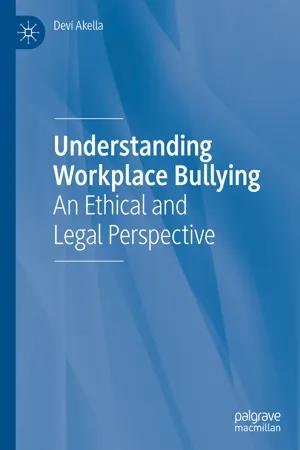1.1 Workplace Bullying: The Beginning
There has been an increase in scholarly interest in the area of workplace mistreatment in the last few decades. Degrading work environments and treatments such as sexual harassment, workplace bullying, and workplace incivility and its implications in terms of safety, integrity, and dignity of employees have caught the attention of organizational behavior scholars and researchers (Akella, 2016; Beale & Hoel, 2011; Roscigno, Hodson, & Lopez, 2009 to mention a few). Among these negative work practices, workplace bullying has been acknowledged, ethically and legally, as a harmful, abusive organizational phenomenon which has drastic long-term recuperations for employees, organizational performance, and productivity (Hutchinson, Vickers, Jackson, & Wilkes, 2005).
The Oxford English Dictionary defines a bully as an individual who oppresses others through use of fear and threats (Kumar, Jain, & Kumar, 2012). Commonly found in schools, bullying takes the form of physical and verbal intimidation and social exclusion (Rayner & Hoel, 1997). Brodsky (1976) was the first to discuss bullying at workplaces in her book The Harassed Worker, while Namie and Namie (2003) used “bullying” as a vocabulary term specific to American employment relations. Workplace bullying is also referred to as mobbing, psychological terror, workplace harassment, and emotional abuse (Kumar, Jain, & Kumar, 2012). It constitutes “repeated and persistent negative actions aimed at one or more individuals” with a singular intent to hurt, intimidate, and humiliate the individual or individuals (Akella, 2016). Workplace bullying evolves from a desire to hurt, subjugate, and suppress another individual, a combination of “desire to hurt + hurtful action + power imbalance + repetitive aggressor + a sense of being oppressed by the victim” (Rigby, 2002, p. 6). An employee is exposed continuously to constant abuse, offensive remarks, ridicule, and criticism. These repetitive and negative physical, verbal, or psychological acts wear down a person (Rayner & Hoel, 1997), make him/her feel demeaned, inadequate, and incompetent causing distress, anxiety, stress, and harm to the individual (i.e., victim) (Hershcovis, 2011). It is a painful process which “persistently provokes, pressurizes, frightens, intimidates … discomforts another person” (Brodsky, 1976, p. 2), raising concerns about human rights violations, ethical code of conduct, and legal protections for individuals while at work (Carbo, 2009).
Bullying at the workplace would involve assigning heavy workloads to one’s employees, professionally attacking the victim, unfairly criticizing them, and allocating menial tasks to them (Fox & Stallworth, 2006; Yildirim, 2009). It also involves ignoring someone, not returning their phone calls and emails, and ridiculing and making fun of them (Randle, Stevenson, & Grayling, 2007). Workplace bullying thus results in employee turnover, absenteeism, higher stress levels, workplace injuries, and illnesses (Carbo, 2009). Exposure to bullying while at work interferes with one’s ability to work, heightens anxiety levels, burnout, depression, and helplessness, induces negative emotions such as anger, resentment, and fear, and lowers one’s self-esteem and self-efficacy (Keashly & Neuman, 2004). Bullying has also been linked with suicidal thoughts, suicide contemplations, and posttraumatic stress disorders (Rayner, Hoel, & Cooper, 2002). In fact, illness, suicide, and death could be the final chapters in a victim’s life (Davenport, Schwartz, & Elliot, 2002). Workplace bullying is a “crippling and devastating problem for [all] employees” (Einarsen, 1999, p. 16).
But surprisingly despite these dire consequences, unlike sexual harassment and racial discrimination, which are legally prohibited within organizations, workplace bullying to a large extent lacks legal protection, with the bully not being punished by the management (Akella, 2016; Baillien, Neyens, De Witte, & De Cuyper, 2009). Bully’s behavioral tendencies are ignored or interpreted as an authoritative style of management, which can be a little aggressive at times (Baillien et al., 2009; Cortina, 2008), and dismissed as “it’s all in the mind” of an overly, sensitive employee (McIntyre, 2005, p. 60). Workplace bullying gets managerial acceptance in this unequal quotient of power and hierarchy between employees and management. It gets approved as a political strategy exercised to achieve organizational goals and objectives (Hutchinson, Vickers, Jackson, & Wilkes, 2010). Managers, after all, need to exercise different types of power strategies to get things done by their subordinates (Cortina, 2008; Hutchinson et al., 2010). In these circumstances, workplace bullying conveniently gets legitimized as a rational tool to “influence and control employees when seeking achievement of organizational goals” (Hutchinson et al., 2010, p. 29). It is a political tactic adopted by managers encompassing petty tyrannical behavior consisting of harassment, intimidation, and fear to gain an advantage over the employees to ensure completion of official duties and responsibilities. It is a part of the disciplinary process used by the ruling managerial class (Burrell & Morgan, 1979) to sustain order and authority within the organization (Hazen, 1994), similar to scientific management (Taylor, 1947), bureaucracy (Weber, 1947), theory X ideology (McGregor, 1960), or the direct form of control advocated by Friedmann (1977). Thus, all forms of abusive behaviors, instead of being questioned for their ethical nature, get legitimized as disciplinary measures used by the management to control employees effectively.
It is possible to expose these hidden power dynamics in workplace bullying (Samnani, 2013), and its relationship to the capitalist framework of society using different types of theoretical approaches integrated within the critical management studies (CMS) paradigm. A critique using different types of theoretical lens would enable portrayal of diverse and varied facets and pictures of workplace bullying as a psychological and degrading type of control measure often used...
